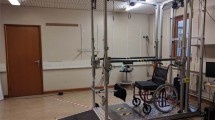Abstract.
Animal models in spine research are often criticized for being irrelevant to the human situation due to the horizontal position of the spine. Whether this is justified from a biomechanical point of view can be questioned. The purpose of the study reported here was to provide arguments that a quadruped can be a valuable in vivo model for the study of the spine in spite of its horizontal position. Relevant literature is reviewed, and biomechanical analyses were made of the standing and walking quadruped. Further, the vertebral trabecular bone architecture was quantitatively analysed by computer and interpreted in the light of Wolff's law. Due to the fact that spinal segments cannot withstand substantial bending moments, additional tensile forces from muscles and ligaments are necessary to control the posture of a quadruped spine. As a consequence, the spine is mainly loaded by axial compression. The trabeculae in a goat's vertebral body were found to course horizontally between its anterior and posterior endplates, implying that the main load within the vertebral body was indeed an axial compression force. The density of the vertebrae of quadrupeds is higher than that of human vertebrae, suggesting that the quadruped has to sustain higher axial compression stresses. The quadruped spine is mainly loaded along its long axis, just like the human spine. The quadruped can thus be a valuable animal model for spine research. An important point of difference is the higher axial compression stress in quadrupeds, which leads to higher bone densities in the vertebrae. This puts some limitations on the transferability of the results of animal experiments to the human situation.
Similar content being viewed by others
Author information
Authors and Affiliations
Rights and permissions
About this article
Cite this article
Smit, T.H. The use of a quadruped as an in vivo model for the study of the spine – biomechanical considerations. Eur Spine J 11, 137–144 (2002). https://doi.org/10.1007/s005860100346
Received:
Revised:
Accepted:
Published:
Issue Date:
DOI: https://doi.org/10.1007/s005860100346




